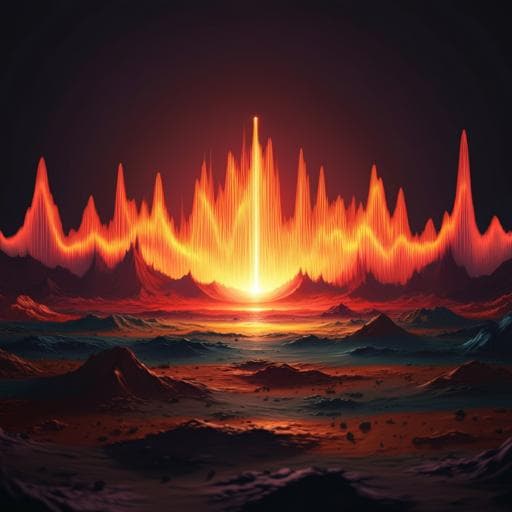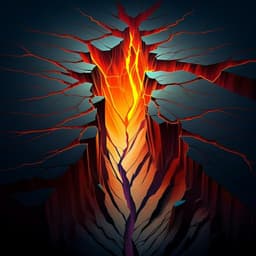
Earth Sciences
Tremor along the Dead Sea Transform remotely triggered by the 2023 Mw7.6 Kahramanmaraş earthquake
A. Inbal
This research by Asaf Inbal investigates the intriguing tremor events triggered by the 2023 Mw7.6 Kahramanmaraş earthquake along the Dead Sea Transform and the Carmel-Fari'a Fault. The findings reveal unique spectral characteristics and challenge existing models of seismic activity.
~3 min • Beginner • English
Introduction
The study investigates the occurrence and characteristics of tectonic tremor along the Dead Sea Transform (DST) that was remotely triggered by the 2023 Kahramanmaraş earthquake sequence. Tectonic tremor spectra are challenging to model due to masking by ambient noise below ~1 Hz and coda contamination above ~1 Hz, typically peaking at 2–8 Hz with sharp high-frequency decay. Competing models attribute tremor either to superposed low-frequency earthquakes (LFEs) or to inertial vibrations of a frictionally controlled oscillator. Distinguishing spontaneous tremor (often coincident with slow slip events) from instantaneous remotely triggered tremor (occurring only during passage of large-earthquake surface waves) helps constrain source processes because triggering stresses are better known and amplitudes are larger. The 2023 Mw7.8–7.6 doublet strongly perturbed seismicity in Israel/Palestine along the DST and Carmel-Fari’a Fault (CFF). This work provides the first account of tremor along the DST, evaluates its spectral properties against other regions (San Andreas, San Jacinto, Hikurangi), and explores source models consistent with observed spectral variability.
Literature Review
- Tremor spectral behavior: Ambient tremor displacement spectra have often been reported to decay as f^-1 above ~1 Hz, with higher-frequency fall-offs of f^-2 to f^-3 at >10 Hz in some regions.
- Source models: (1) Tremor as sequences of LFEs (low-frequency, high-frequency-depleted compared to regular earthquakes). (2) Tremor as inertial vibrations of a frictionally controlled oscillator. Both can reproduce first-order temporal and spectral features but imply different source physics.
- Triggering context: Remotely triggered tremor has been documented along the SAF (Parkfield), SJF (Anza), and Hikurangi; its analysis benefits from better-constrained transient stresses compared to spontaneous tremor associated with slow slip.
- Regional tectonics: The DST accommodates ~5 mm/yr Sinai–Arabia relative motion, with long quiescent intervals and known historical large earthquakes. The Jordan Valley segment near the Dead Sea is a seismic gap with ~1000 years without major events.
Methodology
- Data: Strong-motion accelerometers from the TRUAA network in Israel and Palestine were analyzed (broadband sensors clipped during surface waves). Acceleration and derived velocity records were used.
- Tremor search: Acceleration time series were band-pass filtered 8–16 Hz (following prior work) and visually inspected for tremor-like signals coincident with surface-wave passages of the Mw7.8 and Mw7.6 mainshocks.
- Envelope processing: Seismograms were integrated to velocity, band-pass filtered (8–16 Hz), squared, summed across three components, and smoothed with a 2 s running median to generate energy envelopes with improved SNR for weak signals.
- Location: Envelope Cross-Correlation with a grid-search assuming uniform S-wave velocity of 3 km/s and constant trial depths. Travel times from each grid node to stations were used to time-shift envelopes, cross-correlated, and stacked; the maximum stack across depths provided the preferred hypocenter. Network geometry was near-linear; depth less well constrained.
- Spectral analysis: Doubly integrated accelerations (displacements) were used to compute ground-motion spectra for tremor and for local DST earthquakes (1.9 < M < 3), and compared to triggered tremor spectra from Parkfield (SAF), Anza (SJF), and Hikurangi. Spectra were corrected for geometrical spreading and averaged over stations; high-pass filtering (e.g., >4 Hz for Jordan Valley) was used to suppress surface-wave coda.
- Dynamic deformation metrics: Peak ground velocities (PGV) and dynamic velocity gradients associated with the two Turkish mainshocks were computed along profiles to assess triggering potential and spatial maxima.
- Source modeling: Two forward spectral source models were explored to interpret high-frequency decay: (1) frictionally controlled dynamic oscillator producing oscillatory moment-rate with an acceleration phase; (2) LFE-swarm model where individual ω^2 LFEs are temporally modulated by a (smoothed) comb function with Poisson-distributed inter-event times and exponentially distributed amplitudes; smoothing of the modulation function E yields an effective high-frequency decay ~f^-3. Model parameters include oscillation period, acceleration duration, LFE durations (τ_s), and recurrence intervals (τ_c).
Key Findings
- First observation of instantaneous tremor along the DST: Tremor was detected in the Jordan Valley, north of the Dead Sea, associated with the Mw7.6 mainshock; bursts (~10 s each) align with Love-wave amplitude maxima and vanish as surface-wave energy decays.
- Location and depth: The strongest tremor source is located near Kirbhet Samara, between the main DST strand and the CFF; depth is estimated at ~10–20 km, near the base of the seismogenic zone.
- Distinct from local earthquakes: Tremor envelopes and waveforms are emergent, lack clear P/S arrivals, have longer durations than nearby M2.1 earthquake S-wave and coda, and differ spectrally from local earthquakes recorded within ~5 km of the tremor source.
- Additional triggered event: An instantaneously triggered microearthquake was located ~5 km north of Jenin (southern Jezre’el Valley) during Mw7.6 surface-wave passage; some stations recorded both signals without temporal overlap.
- Triggering by Mw7.6 vs Mw7.8: Despite larger magnitude, the Mw7.8 did not instantaneously trigger tremor/earthquakes in the study area. Average PGVs from Mw7.6 were only ~5% higher than Mw7.8 (max ~15%) and did not spatially coincide with triggered sources. However, dynamic velocity gradients from Mw7.6 surface waves were locally amplified by up to a factor of ~2 relative to Mw7.8, and triggered source locations coincide with long-period deformation gradient maxima.
- Spectral character of DST tremor: In 4–13 Hz, Jordan Valley tremor displacement spectra decay rapidly ~f^-3 and are extremely depleted in high-frequency energy compared to local earthquakes (which show slower decay with rapid drop above ~10 Hz due to inelastic attenuation). Below ~4 Hz, tremor estimates are contaminated by Mw7.6 coda, preventing robust magnitude estimation.
- Inter-regional comparisons: Triggered tremor spectra vary by region. SAF (Parkfield) decays ~f^-1 below ~5 Hz and ~f^-2 above; SJF decays ~f^-1 from ~1.5–8 Hz; Hikurangi is similar in shape to SJF but with much larger amplitude. None are as loud and high-frequency-depleted as the DST tremor in the 1–10 Hz band.
- Modeling implications: Both an inertial frictional oscillator and an LFE-swarm with smoothed temporal modulation can reproduce the observed high-frequency fall-off (~f^-3) of the DST tremor displacement spectra. The ratio of LFE durations to recurrence (τ_s/τ_c) controls low-frequency behavior: LFE-poor tremor (τ_s > τ_c) can yield higher-frequency enrichment, while overlapping LFEs (τ_s < τ_c) enrich low frequencies.
Discussion
Findings address the central question of how remotely triggered tremor is generated and what controls its spectral variability. The spatial coincidence of triggered tremor/earthquake with maxima in long-period dynamic velocity gradients from the Mw7.6 suggests that dynamic strain gradients, not merely PGV proxies, govern instantaneous triggering efficiency. The unusually strong, high-frequency-depleted DST tremor indicates source and/or near-source medium properties distinct from typical continental transform tremor.
Two contrasting, yet viable, source models explain the observed high-frequency spectral decay: (1) A frictionally controlled inertial oscillator, in which surface-wave-driven high loading rates or low effective stress induce sustained oscillatory slip, produces distinct moment-rate functions whose acceleration phase and oscillation period control spectral slopes (yielding decay up to f^-3). (2) An LFE-swarm model with ω^2 LFEs and a smoothed temporal modulation function E can also produce high-frequency decay ~f^-3, with low-frequency slopes controlled by LFE overlap (τ_s/τ_c). These models imply different fault-zone physics: inertial resonance under high-rate loading vs. superposed small-scale rupture episodes.
Regional spectral variability (SAF vs SJF vs Hikurangi vs DST) likely reflects differences in tremor source richness (number/overlap of LFEs), frictional properties, and/or strong near-fault attenuation. The SJF may become tremorgenic only under high transient stressing rates, producing triggered but not necessarily spontaneous tremor, whereas Parkfield’s behavior may reflect relatively LFE-poor triggering conditions. The structural amplification of Mw7.6 long-period gradients, potentially related to DST–CFF intersection structure or basin resonance/conversion effects, may also enhance triggering efficiency.
Conclusion
- This study documents the first instantaneous triggered tremor along the DST and a contemporaneous triggered microearthquake on the CFF, both associated with the Mw7.6 Kahramanmaraş mainshock.
- Triggered sources align with local maxima of long-period dynamic deformation gradients; local amplification relative to the Mw7.8 event is up to a factor of ~2, though the responsible source/structural properties remain uncertain.
- DST tremor displacement spectra are unusually strong yet highly depleted in high frequencies, decaying ~f^-3 from 4–13 Hz, and differ from local earthquake spectra and from other triggered tremor spectra (SAF, SJF, Hikurangi). This demonstrates that tremor spectral fall-off rates are not universal.
- Two forward models—frictionally controlled inertial oscillation and LFE-swarm with smoothed modulation—both reproduce the high-frequency spectral decay, offering different mechanical interpretations of tremorgenic behavior.
- Given evidence that the DST faults were brought closer to failure, enhanced seismo-geodetic monitoring is warranted. Future research should aim to: (i) resolve near-source attenuation and structural amplification mechanisms; (ii) discriminate between LFE-swarm and inertial oscillation through higher SNR observations and depth constraints; (iii) assess whether the DST also hosts spontaneous tremor and characterize its relation to slow slip.
Limitations
- Data limitations: Broadband instruments clipped during strong surface waves; analysis relies on accelerometers, which are less sensitive to weak motions. Only two tremor bursts had SNR > 1.
- Frequency contamination: Below ~4 Hz, tremor estimates are contaminated by Mw7.6 coda, precluding robust low-frequency characterization and magnitude estimation.
- Location uncertainties: Near-linear network geometry and assumptions of uniform S-wave velocity (3 km/s) and constant source depth limit depth resolution (depth only constrained to ~10–20 km).
- Structural uncertainty: The cause of local amplification of long-period gradients (up to 2× for Mw7.6 vs Mw7.8) is unknown; possible focusing, basin resonance, or wave-conversion effects are hypothesized but unconfirmed.
- Potential signal misidentification: Although quarry blasts and anthropogenic sources were considered unlikely based on timing, correlation across stations, depth estimates, and spectral differences, residual ambiguity cannot be entirely excluded.
Related Publications
Explore these studies to deepen your understanding of the subject.







